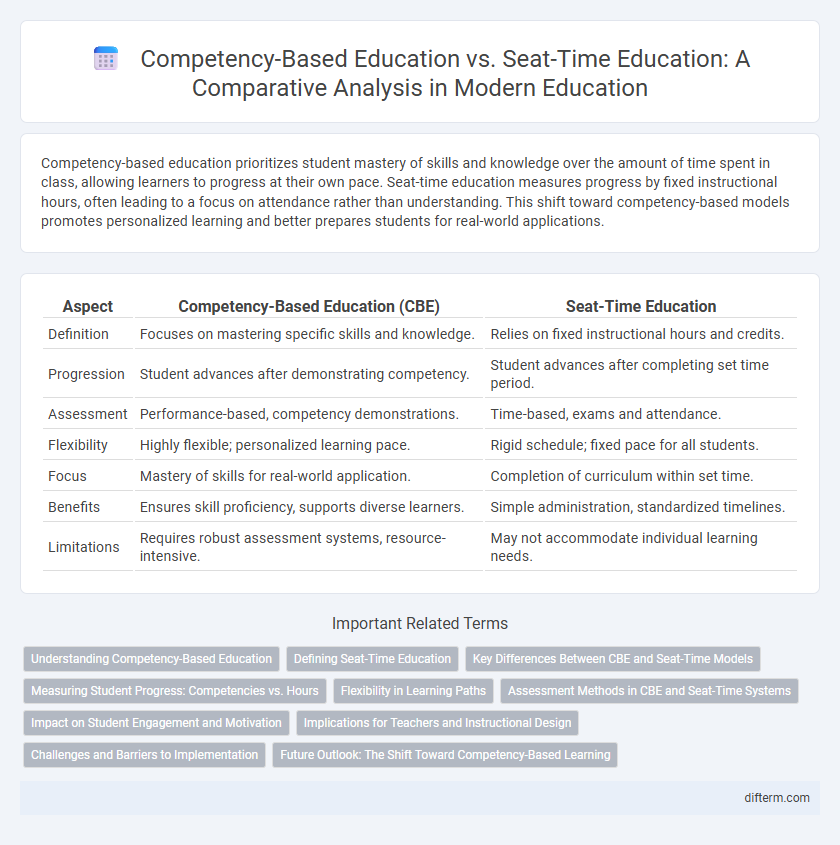Competency-based education prioritizes student mastery of skills and knowledge over the amount of time spent in class, allowing learners to progress at their own pace. Seat-time education measures progress by fixed instructional hours, often leading to a focus on attendance rather than understanding. This shift toward competency-based models promotes personalized learning and better prepares students for real-world applications.
Table of Comparison
| Aspect | Competency-Based Education (CBE) | Seat-Time Education |
|---|---|---|
| Definition | Focuses on mastering specific skills and knowledge. | Relies on fixed instructional hours and credits. |
| Progression | Student advances after demonstrating competency. | Student advances after completing set time period. |
| Assessment | Performance-based, competency demonstrations. | Time-based, exams and attendance. |
| Flexibility | Highly flexible; personalized learning pace. | Rigid schedule; fixed pace for all students. |
| Focus | Mastery of skills for real-world application. | Completion of curriculum within set time. |
| Benefits | Ensures skill proficiency, supports diverse learners. | Simple administration, standardized timelines. |
| Limitations | Requires robust assessment systems, resource-intensive. | May not accommodate individual learning needs. |
Understanding Competency-Based Education
Competency-based education measures student learning through mastery of specific skills and knowledge rather than time spent in a classroom, promoting personalized pacing and practical application. This approach ensures learners acquire essential competencies before advancing, improving retention and real-world readiness. Compared to seat-time education, competency-based models emphasize outcomes and flexibility, catering to diverse learning needs and enhancing overall educational effectiveness.
Defining Seat-Time Education
Seat-time education is defined by a fixed schedule where students advance based on the amount of time spent in class rather than mastery of specific skills or knowledge. It emphasizes completing predetermined hours or credit units, often leading to uniform progression regardless of individual learning pace or competency. Critics argue this model can hinder personalized learning and fail to accurately measure student proficiency in core subjects.
Key Differences Between CBE and Seat-Time Models
Competency-based education (CBE) centers on mastering specific skills and knowledge at an individualized pace, contrasting with seat-time education that relies on completing fixed hours in a classroom setting. CBE prioritizes demonstrated proficiency through assessments, while seat-time models emphasize attendance and time spent in structured lessons. This shift towards competency measurement enhances personalized learning pathways and better aligns educational outcomes with real-world skills.
Measuring Student Progress: Competencies vs. Hours
Competency-based education measures student progress through mastery of specific skills and knowledge, allowing for personalized pacing and deeper understanding. Seat-time education relies on predetermined hours spent in class, often overlooking individual learning differences and mastery levels. This shift towards competencies ensures accurate assessment of student capabilities rather than time-based attendance metrics.
Flexibility in Learning Paths
Competency-based education offers personalized learning paths that adapt to students' individual progress and mastery, enabling flexibility beyond fixed schedules. Seat-time education requires students to complete a set amount of hours or days in class, limiting adaptability to varied learning speeds and styles. This flexibility in competency-based models supports diverse learners by allowing accelerated advancement or extended support based on demonstrated skills rather than time spent.
Assessment Methods in CBE and Seat-Time Systems
Competency-based education employs performance-based assessments, including project portfolios, practical demonstrations, and real-world problem-solving tasks that directly measure skills and knowledge mastery. In contrast, seat-time education relies primarily on time-based assessments such as standardized tests and timed exams that emphasize content coverage over individual mastery. The shift toward competency-based assessment methods enhances personalized learning by evaluating students' actual abilities rather than their time spent in class.
Impact on Student Engagement and Motivation
Competency-based education boosts student engagement by allowing learners to progress at their own pace, fostering intrinsic motivation through mastery of skills rather than time spent in class. In contrast, seat-time education often limits motivation by emphasizing attendance and fixed schedules, which can disengage students who grasp concepts quickly or need more time. Studies show that competency-based models increase perseverance and active participation, leading to higher academic achievement and satisfaction.
Implications for Teachers and Instructional Design
Competency-based education shifts the teacher's role from traditional lecturing to facilitating personalized learning paths, requiring instructional designs that prioritize mastery of skills over fixed schedules. This approach demands assessment strategies that continuously evaluate student progress through real-world applications rather than time spent in class. Instructional design must be flexible, modular, and adaptive to accommodate varied learning paces and provide targeted interventions, enhancing both teaching effectiveness and learner outcomes.
Challenges and Barriers to Implementation
Competency-based education faces challenges such as aligning assessment methods with mastery-based outcomes and ensuring consistent standards across diverse learning environments. Seat-time education struggles with the rigidity of predetermined schedules that limit personalized pacing and often fail to address individual learning needs. Both models encounter barriers related to faculty training, institutional readiness, and the integration of technology to support flexible, competency-driven progress tracking.
Future Outlook: The Shift Toward Competency-Based Learning
Competency-based education (CBE) emphasizes mastery of skills and knowledge, allowing students to progress at their own pace, contrasting sharply with traditional seat-time education that relies on fixed instructional hours. The future outlook shows a significant shift toward CBE, driven by technological advancements, personalized learning models, and employer demand for demonstrable competencies. Educational institutions increasingly adopt competency frameworks to enhance student outcomes and better align curricula with workforce needs, signaling a transformative change in how learning achievement is measured.
competency-based education vs seat-time education Infographic

 difterm.com
difterm.com